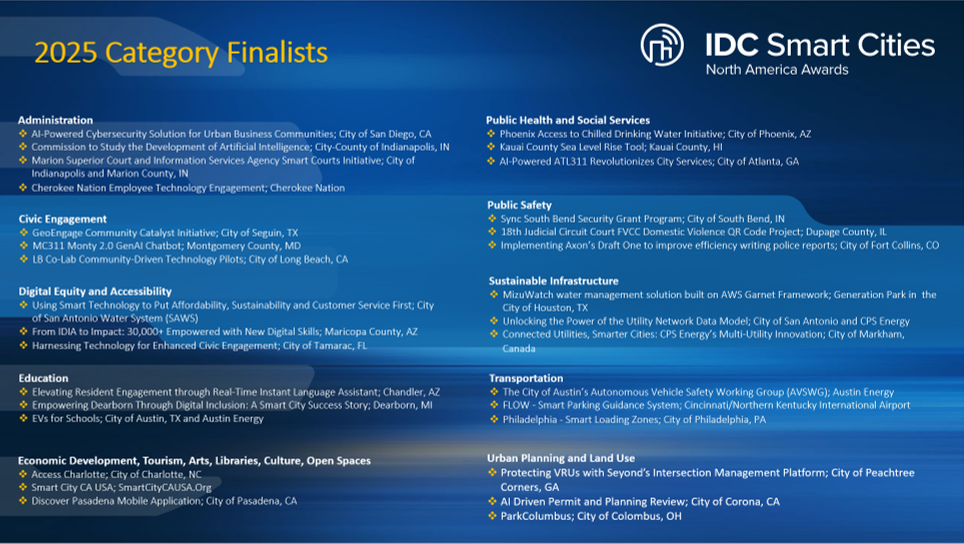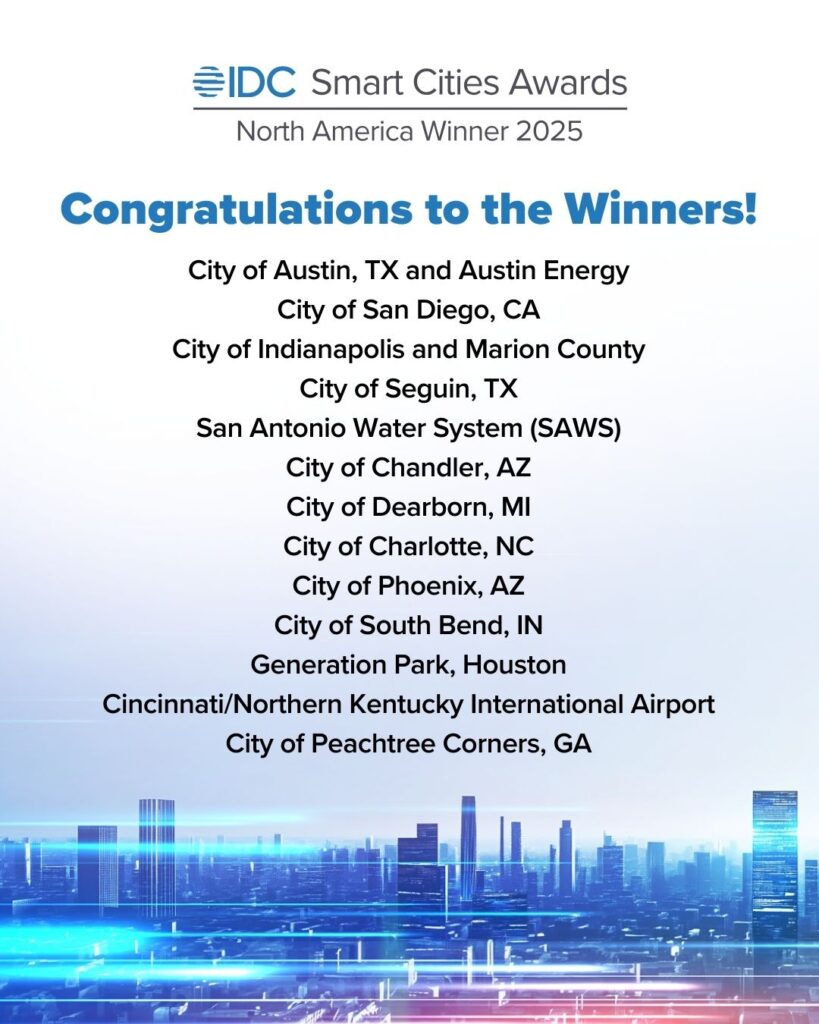I’ve been hosting the IDC Smart Cities Awards since 2018 and this year was the first time that I got choked up multiple times during the awards ceremony. And I wasn’t the only one!
IDC’s Smart City North America awards were hosted at Smart Cities Connect, held in beautiful San Antonio. As the award winners receive their awards, each team has a chance to say a few words about their initiative and this year their messages were powerful, personal and showed the passion for their work.
The award recipient from the City of Charlotte, Jamar Davis, whose project “Access Charlotte” focused on housing as a means to drive access to broadband, was emotional as he talked about his connection to the places he was serving. Amy Atchley from the City of Austin said, when describing their project with Austin Energy, “Smart cities is for dreamers.” She didn’t mean Smart Cities are hypothetical; she meant this is a group that is dreaming big and, slowly but surely, realizing those dreams. These were just two of the speakers that moved me and the rest of the attendees.
We can see the practical application of technology to big ideas and big challenges in the agenda from Smart Cities Connect where we host the awards. From Digital Transformation and urban operations to community engagement, cities and their tech partners came together to demonstrate how their use of technology has matured in service to the public. Our award winners and finalists are a microcosm of this.

Here are just a few examples of the innovative projects that made this year’s IDC Smart City North America winners and finalists so impressive, and the three key take-aways from the winners.
Deliver on What Your Community Needs and Wants
- The city of Phoenix, AZ – the hottest city in the US – discovered that their residents wanted access to chilled drinking water. With ideas from the community, the city developed a custom-designed water station that features two drinking spouts at ADA-approved heights, a bottle filling station, an internal chiller, and smart meters for reporting live water usage data via a central dashboard. The initiative is tackling hydration and heat concerns by establishing a network of modern, chilled fountains that enhance resilience to extreme heat, reduce plastic waste, and support access to essential services like work and healthcare.
- The City of Chandler, AZ developed an Instant Language Assistant (ILA) that tested real-time translation tools to improve resident communication across 250 languages. Custom devices, used at city service counters and events, the ILA supported over 560 face-to-face interactions and enabled communication through headsets, keyboards (including Braille), and ASL support. Success stories included a hearing-impaired resident renewing a passport and immediate language support in libraries and housing services. Following the pilot’s success, city leadership approved funding for 60 ILA units over three years, making Chandler a regional leader in inclusive, tech-driven public service.
Do the Hard Work to take Partnerships to a New Level to Achieve Scaled Results
- The City of San Antonio worked with two utilities and their initiative showcases the power of inter-utility collaboration, maximizing shared infrastructure to improve service reliability, and empowering residents with real-time insights and enable more efficient operations. San Antonio Water System (SAWS) modernized its 600,000-endpoint water network by replacing manual meter reading with advanced metering infrastructure (AMI). Faced with labor challenges, rising costs, and billing delays, SAWS partnered with CPS Energy to use its existing industrial IoT (IIoT) network, avoiding the cost of building a new system. A pilot using 2,500 ultrasonic meters showed near-perfect read accuracy, real-time usage data, and early leak detection, improving billing, customer engagement, and conservation. The shared network supports future smart city uses, setting an example of how cross-utility collaboration can increase ROI, operational efficiency, and resident satisfaction.
- South Bend, IN launched an innovative grant program to expand the city’s Real-Time Crime Center (RTCC) by partnering with local organizations to enhance security infrastructure. Run by SBPD and the Department of Innovation & Technology, the program offers up to $4,000 for eligible investments like cameras and software by local businesses. In return, participants integrate their security systems into the RTCC via the FususCORE device. Since launch, 39 organizations have joined, adding 171 camera views—a 51% increase in RTCC coverage. Benefits include improved incident response, deterrence, and stronger community-police ties. The program prioritizes privacy and transparency and has already helped SBPD address 13 safety incidents.
Embed Resilience and Sustainability in Project Design
- The Cincinnati/Northern Kentucky International Airport modernized its main garage by addressing poor lighting, high energy use, and inefficient space utilization. The outdated sodium vapor lighting was costly and limited future upgrades like EV charging. The project introduced LED lighting, IoT sensors, and a data platform to improve navigation, safety, and energy efficiency. Goals included enhancing passenger experience, expanding infrastructure, reducing costs, and achieving ROI within 3.5 years. The system enabled real-time parking guidance, supported scalable innovation, and created new revenue opportunities through better space management and pricing strategies. Overall, the project marked a transformative shift in airport parking operations through smart, sustainable technology.
- Generation Park Generation Park, a 4,300-acre master-planned community in Northeast Houston, is a public-private partnership between McCord Development and the Generation Park Management District. Facing high water bills and unaccounted water loss due to aging infrastructure and lack of monitoring tools, McCord built MizuWatch, a digital twin IoT water monitoring platform, using the AWS Garnet Framework based on FIWARE open standards. MizuWatch enables real-time water usage analytics, leak detection, and system transparency. It helped reduce billing and improve efficiency by identifying leaks and enabling proactive collaboration with water operators. The Garnet Framework also prevents vendor lock-in and will serve as the data foundation for future smart city initiatives in Generation Park.
One project embodied all of these – Austin Energy’s EVs for Schools initiative which provides an educational living lab that is scaling country-wide. Austin Energy is supporting Austin’s goals to be net zero emissions by 2040 which requires 40% of all vehicle miles traveled to be electric by 2030. To achieve these goals, Austin Energy is educating community members on transportation electrification via a sustainable transportation curriculum prioritizing students from disadvantaged communities. Teachers are provided with a digital tool kit and training highlighting STEM education, environmental justice, EVs, clean energy and sustainable mobility. Austin Energy conducts EV workshops introducing students to fun, leading-edge concepts around EV technology, an EV virtual reality experience, and field trip adventures.
These are just a few of many amazing projects. We had a very difficult time choosing the winners from the list of finalists. And I wish I could expand on all the projects in this blog, but that will come later in a more detailed write-up.

The IDC Smart Cities Awards program isn’t just about recognizing the work communities are doing all around North America, it’s also to connect peers to learn from each other and share our continued vision for the future of our communities. We hope more organizations and municipalities will join us next year!
To learn more about IDC’s work with cities and communities, and our 2026 Smart City Awards, please visit us at IDC.com.




